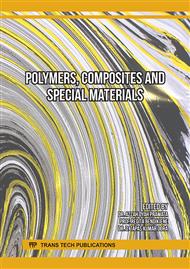[1]
A. Ispas, L. Iosif, D. Popa, M. Negucioiu, M. Constantiniuc, C. Bacali, S. Buduru, Comparative assessment of the functional parameters for metal-ceramic and all-ceramic teeth restorations in prosthetic dentistry – A literature review. Biology. 11(4) (2022) 556
DOI: 10.3390/biology11040556
Google Scholar
[2]
H. Hesse, M. Özcan, A review on current additive manufacturing technologies and materials used for fabrication of metal-ceramic fixed dental prosthesis. J. Adhes. Sci. Technol. 35 (2021) 2529-2546
DOI: 10.1080/01694243.2021.1899699
Google Scholar
[3]
J. Souza, B. Henriques, E. Ariza, A.E. Martinelli, R.M. Nascimento, F.S. Silva, L.A. Rocha, J.P. Celis, Mechanical and chemical analyses across dental porcelain fused to CP Ttitanium or Ti6Al4V. Mater. Sci. Engin. C. 37 (2014) 76-83
DOI: 10.1016/j.msec.2013.12.030
Google Scholar
[4]
J. Hong, S. Kim, S. Heo, J.Y. Koak, Mechanical properties and metal-ceramic bond strength of Co-Cr alloy manufactured by selective laser melting. Materials. 13 (2020) 5745
DOI: 10.3390/ma13245745
Google Scholar
[5]
K. Dimitriadis, T. Papadopoulos, S. Agathopoulos, Effect of bonding agent on metal-ceramic bond strength between Co-Cr fabricated with selective laser melting and dental feldspathic porcelain. J. Prosthodont. 28(9) (2019) 1029-1036
DOI: 10.1111/jopr.13058
Google Scholar
[6]
M. Sarraf, E. Ghomi, S. Alipour, S. Ramakrishna, N. Liana Sukiman, A state‑of‑the‑art review of the fabrication and characteristics of titanium and its alloys for biomedical applications. Bio-Des. Manuf. 5 (2022) 371-395
DOI: 10.1007/s42242-021-00170-3
Google Scholar
[7]
H. Koizumi, Y. Takeuchi, H. Imai, T. Kawai, T. Yoneyama, Application of titanium and titanium alloys to fixed dental prostheses. J. Prosthodontic Res. 63 (2019) 266-270
DOI: 10.1016/j.jpor.2019.04.011
Google Scholar
[8]
M. Antanasova, A. Kocjan, J. Kovač, B. Žužek, P. Jevnikar, Influence of thermo-mechanical cycling on porcelain bonding to cobalt–chromium and titanium dental alloys fabricated by casting, milling, and selective laser melting. J. Prosthodontic Res. 62(2) (2018) 184-194
DOI: 10.1016/j.jpor.2017.08.007
Google Scholar
[9]
Z.A. Çevik, K. Özsoy, A. Ercetin, The effect of machining processes on the physical and surface morphology of Ti6Al4V specimens produced through powder bed fusion additive manufacturing. Int. J. 3D Printing Technol. Digital Ind. 5(2) (2021) 187-94
DOI: 10.46519/ij3dptdi.947650
Google Scholar
[10]
T.D. Dikova, D.A. Dzhendov, Y.V. Gagov, Surface morphology and roughness of Ti6Al4V alloy manufactured by milling and selective laser melting (in Bulgarian). Proceedings of INNOVATIONS 2022, Varna, Bulgaria, 20-23 June 2022; Publisher STUME, Sofia, Bulgaria, 1(6) (2022) 48-55.
DOI: 10.1016/j.prostr.2022.12.193
Google Scholar
[11]
M. Antanasova, A. Kocjan, M. Hocevar, P. Jevnikar, Influence of surface airborne-particle abrasion and bonding agent application on porcelain bonding to titanium dental alloys fabricated by milling and by selective laser melting. J. Prosthetic Dent. 123 (2020) 491-499
DOI: 10.1016/j.prosdent.2019.02.011
Google Scholar
[12]
İ. Tepe, R. Nigiz, Z. Polat, S.M. Ünal, The effect of ytterbium-doped fiber laser on titanium fused to ceramic. Int. Dent. Res. 11(1) (2021) 128-136
Google Scholar
[13]
M. Lubas, J. Jasinski, P. Jelen, M. Sitarz, Effect of ZrO2 sol-gel coating on the Ti 99.2 – porcelain bond strength investigated with mechanical testing and Raman spectroscopy. J. Molecular Struct. 1168 (2018) 316-321
DOI: 10.1016/j.molstruc.2018.04.086
Google Scholar
[14]
M. Lubas, J. Jasinski, A. Zawada, I. Przerada, Influence of sandblasting and chemical etching on titanium 99.2–dental porcelain bond strength. Materials. 15 (2022) 116
DOI: 10.3390/ma15010116
Google Scholar
[15]
K. Anusavice, C. Shen, H. Rawls, Phillips' science of dental materials. 12 ed., Elsevier Inc. 2013.
Google Scholar
[16]
M. Yan, C.T. Kao, J.S. Ye, T.H. Huang, S.J. Ding, Effect of preoxidation of titanium on the titanium–ceramic bonding. Surf. Coat. Technol. 202(2) (2007) 288-293
DOI: 10.1016/j.surfcoat.2007.05.056
Google Scholar
[17]
M. Antanasova, A. Kocjan, A. Abram, J. Kovač, P. Jevnikar, Pre-oxidation of selective-laser-melted titanium dental alloy: effects on surface characteristics and porcelain bonding. J. Adhes. Sci. Technol. 35(19) (2021) 2094-2109
DOI: 10.1080/01694243.2021.1877003
Google Scholar
[18]
T.D. Papadopoulos, K.D. Spyropoulos, The effect of a ceramic coating on the cpTi–porcelain bond strength. Dent. Mater. 25(2) (2009) 247-253
DOI: 10.1016/j.dental.2008.06.008
Google Scholar
[19]
I. Al Hussaini, K.A. Al Wazzan, Effect of surface treatment on bond strength of low-fusing porcelain to commercially pure titanium. J. Prosthetic Dent. 94(4) (2005) 350-356
DOI: 10.1016/j.prosdent.2005.07.007
Google Scholar
[20]
N. Suansuwan, M.V. Swain, Adhesion of porcelain to titanium and a titanium alloy. J. Dentist. 31(7) (2003) 509-518
DOI: 10.1016/S0300-5712(03)00071-X
Google Scholar
[21]
Scheftner Dental Alloys, Ti Milling Discs, Starbond Ti5 Disc. Information on https://scheftner.dental/starbond-ti5-disc-en.html
Google Scholar
[22]
Carpenter Additive, PowderRange Ti64, Datasheet, 2020 CRS Holdings Inc., 7p. Information on https://www.carpenteradditive.com/resources
Google Scholar
[23]
Carpenter Additive, CT PowderRange Ti64 F, Technical data sheet, 2019 CRS Holdings, Inc., 4 p. Information on www.carpenteradditive.com
Google Scholar
[24]
Vita, VITA LUMEX AC, Instruction for use/Full version, VITA Zahnfabrik H. Rauter GmbH & Co.KG, Bad Sackingen, Germany, 54 p. Information on https://www.vita-zahnfabrik.com/en/VITA-LUMEX-AC-87902,27568.html
DOI: 10.1055/s-2005-864066
Google Scholar
[25]
Vita, VITA NP BOND Paste, Instructions for use, VITA Zahnfabrik H. Rauter GmbH & Co.KG, Bad Sackingen, Germany. Information on https://www.vita-zahnfabrik.com/en/VITA-NP-BOND-24580,27568.html
DOI: 10.1055/s-2005-864066
Google Scholar
[26]
T. Dikova, A. Anchev, V. Dunchev, D. Dzhendov, Y. Gagov, Experimental investigation of adhesion strength of dental ceramic to Ti6Al4V alloy fabricated by milling and selective laser melting. Procedia Struct. Integr. 42 (2022) 1520-1528
DOI: 10.1016/j.prostr.2022.12.193
Google Scholar
[27]
W.J. O'brien, Dental materials and their selection. Quintessence, Chicago, Berlin, Tokyo, 2002.
Google Scholar
[28]
X. Han, T. Sawada, C. Schille, E. Schweizer, L. Scheideler, J. Geis-Gerstorfer, F. Rupp, S. Spintzyk, Comparative analysis of mechanical properties and metal-ceramic bond strength of Co-Cr dental alloy fabricated by different manufacturing processes. Materials. 11(10) (2018) 1801
DOI: 10.3390/ma11101801
Google Scholar
[29]
K. Dimitriadis, K. Spyropoulos, T. Papadopoulos, Metal-ceramic bond strength between a feldspathic porcelain and a Co-Cr alloy fabricated with Direct Metal Laser Sintering technique. J. Adv. Prosthodontics. 10(1) (2018) 25-31
DOI: 10.4047/jap.2018.10.1.25
Google Scholar
[30]
S. Zinelis, X. Barmpagadaki, V. Vergos, M. Chakmakchi, G. Eliades, Bond strength and interfacial characterization of 8 low fusing porcelains to cp Ti. Dent. Mater. 26(3) (2010) 264-273
DOI: 10.1016/j.dental.2009.11.004
Google Scholar



